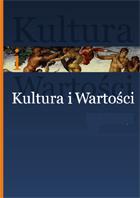Elementy estetyki w Wilhelma Diltheya ujęciu człowieka i kultury
Elements of Aesthetics in Wilhelm Dilthey’s Approach to the Human Being and Culture
Author(s): Anna MusiołSubject(s): Philosophy
Published by: Wydawnictwo Naukowe Uniwersytetu Marii Curie-Sklodowskiej
Keywords: philosophy of culture; anthropology; humanistic psychology; inner experience; understanding; experience; Wilhelm Dilthey
Summary/Abstract: The cultural crisis at the turn of the 19th and 20th centuries expressed the impossibility of qualifying the truth in its absolute conditions, perception and understanding from the committed cognitive attitude of the subject: the human beings whose every action is subject to the influence of history and the way it forms their outlook on life. The remedy for cultural collapse expresses itself through the hegemony of naturalism and the reproach of the lack of full objectivity; methodological self-knowledge in the humanities is a form of authenticity which most distinctly reflects the spontaneous individual’s work, perceived in compliance through the foundations of humanistic descript_ive psychology. The individual, though conditioned by social determinants – and recognizing this – reaches far inside her own spirit to confirm the creative activity, which itself does not recur across a continuous extension of axiological perspectives – as well as of experience and understanding the perception of reality. Skillful, well-versed aesthetically, engaging with the argument from the borderland of the theory of literature, poetry and art also determined with the three categories: Ausdruck –Erleben–Bedeutung, the analysis of the product of the culture additionally qualifies not only the definition of all materially and spiritually acquired possessions of humankind produced by the historical process, but institutes also a manner for perceiving the human being. The conscious subject historically realizes herself in the continuity of life, which determines – as Dilthey suggests – the basis of all human occurrences and experiences. Life in its multidimensionality reveals the creative power of the human being as it appears in the realization of aims which is placed before her. There is an expression of psychical contents which express the human relation to the world; with the intensification sign which – as Zbigniew Kuderowicz suggests – grants the sense to circumjacent objects that change it by converting and acting intelligible in order to form a cultural environment. Taking into account the foundations of anthropology in Dilthey’s Lebensphilosophie, the author represents the attempt to define the human being and her form in reality of the epochal crisis as proposed by the German philosopher of culture.
Journal: Kultura i Wartości
- Issue Year: 2012
- Issue No: 04
- Page Range: 89-96
- Page Count: 8
- Language: Polish

